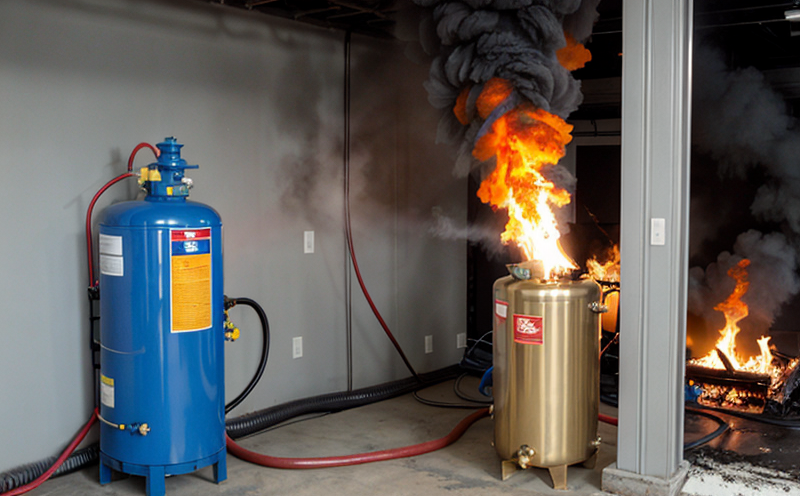Fire Suppression System Maintenance and Inspection Testing
In today’s world, where safety is paramount in various sectors including commercial buildings, industrial facilities, and public venues, ensuring the effectiveness of fire suppression systems through regular maintenance and inspection testing is non-negotiable. Fire suppression systems are designed to extinguish or control fires by applying agents such as water, foam, carbon dioxide, or dry chemicals. The primary goal of this service is to verify that these systems meet the required standards for performance and reliability.
The maintenance and inspection process involves a series of stringent tests aimed at identifying potential flaws in system components before they can cause significant damage during an emergency. This proactive approach ensures that fire suppression systems are always ready to perform when needed, thereby safeguarding lives and property. The testing encompasses multiple aspects including the integrity of piping networks, valve functionality, control panels, nozzles, and detection systems.
Our laboratory employs state-of-the-art equipment and adheres strictly to international standards such as ISO 9715 for water mist fire extinguishing systems and ASFF (Australian Standard Fire Fighting) for foam-based systems. These tests are conducted by experienced technicians who have the necessary qualifications and certifications.
The testing protocol begins with a thorough visual inspection of all components, followed by pressure testing to check for leaks or weak points in piping. Next comes the operation test which involves simulating an activation sequence to ensure that each component functions correctly. This includes checking the release of fire suppression agents under controlled conditions.
Another critical aspect is the thermal imaging scan to detect any areas where heat signatures indicate potential issues within the system. Additionally, we conduct a thorough audit of the environmental conditions such as temperature and humidity levels which can affect system performance. Our team also evaluates the calibration accuracy of fire detection systems and ensures that they are set at optimal thresholds.
Following these tests, detailed reports are generated highlighting any deficiencies found along with recommended corrective actions if necessary. These reports serve not only as compliance documents but also as valuable tools for continuous improvement efforts within organizations. By maintaining high standards in this area, businesses can rest assured knowing that their fire safety measures are robust and reliable.
Regular maintenance and inspection play a crucial role in preventing costly downtime during emergencies while ensuring regulatory compliance across jurisdictions worldwide. Investing time into periodic checks not only protects against unexpected failures but also demonstrates commitment towards maintaining the highest levels of occupational health and safety standards.
Applied Standards
The fire suppression system maintenance and inspection testing service at our laboratory strictly adheres to a variety of international standards to ensure accuracy, consistency, and reliability in our assessments. For water-based systems like sprinklers and deluge valves, we follow the guidelines provided by ISO 9715:2016 & ANSI/UL 1821 which specify performance requirements for these types of fire suppression equipment.
For foam systems used primarily in industrial settings where large volumes are required to combat extensive fires efficiently, our tests comply with the criteria outlined in ASFF (Australian Standard Fire Fighting) and ISO 5807. These standards provide detailed specifications on the composition, application rates, and effectiveness of different foam types.
We also perform compatibility checks between various components within a fire suppression system to ensure they work harmoniously together under emergency conditions. This includes testing combinations of nozzles with specific agents or comparing the output from multiple brands' equipment during simulated activations.
Our rigorous adherence to these recognized standards ensures that our clients receive comprehensive, unbiased evaluations of their fire protection systems. By staying up-to-date on changes and updates within these standards, we can provide cutting-edge solutions tailored specifically for each client's unique requirements.
Benefits
The primary benefit of maintaining and inspecting your fire suppression system lies in its ability to enhance overall safety across all facilities. By regularly testing these systems, you not only ensure compliance with local regulations but also significantly reduce the risk associated with potential failures during critical moments.
Regular maintenance helps identify minor issues early on before they escalate into major problems leading up to catastrophic events. This proactive approach saves both time and money by avoiding costly repairs or replacements that could have been prevented had regular checks been performed earlier.
In addition, this service ensures peace of mind for facility managers who are responsible for the well-being of occupants. Knowing that their fire suppression systems are functioning correctly provides reassurance knowing that they can rely on them when needed most.
From a business perspective, investing in regular testing demonstrates a strong commitment to occupational health and safety standards. This can boost employee morale while potentially reducing insurance premiums due to improved risk management practices.
Moreover, compliance with applicable fire codes and regulations helps organizations avoid legal penalties or costly fines that may arise from non-compliance. It also shows stakeholders that the organization takes its responsibilities seriously, enhancing trust and reputation.
Industry Applications
The application of our fire suppression system maintenance and inspection testing service spans across numerous industries including commercial buildings, industrial complexes, healthcare facilities, educational institutions, and hospitality venues. Each sector has unique requirements based on the type of fire hazards present as well as the specific regulations governing their operations.
For example, in high-rise office buildings where water-based systems are common due to their effectiveness against electrical fires, we conduct thorough inspections focusing heavily on pipe integrity and nozzle spray patterns. Similarly, manufacturing plants that use flammable liquids require specialized foam systems which must be tested rigorously to ensure they can quickly contain large-scale spills.
In healthcare environments where patient safety is paramount, the testing process emphasizes the reliability of early warning systems alongside mechanical components ensuring rapid response times in emergency situations. Educational institutions like schools and universities benefit greatly from regular checks conducted during off-peak hours so as not to disrupt daily activities unnecessarily.





